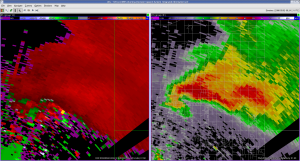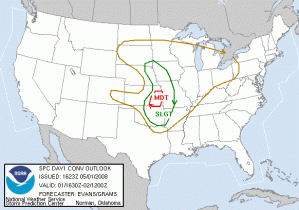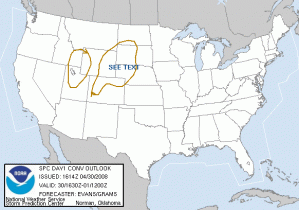Coming into this experiment, I truly did not know what to expect. I did my homework best I could but was still concerned I didn’t learn all the acronyms correctly and would in the long run not be able to add much to the experiment. By the end of the first day, however, any worries I had were put to rest by the great crew at the EWP as they made me feel comfortable and sure I was prepared for the battle of the coming week.
Where to start…let me start with the CASA. Being from a Western Region office that has noticeable radar data gaps, these were the folks I drifted to immediately as I wanted to learn more about their system. After simulations and a presentation of the CASA data I was blown away quickly. I felt as if I was watching some type of different radar data world when viewing the data. To me it made the returns appear as it they were living things. The high resolution and rapid refreshing of the data made it appear as if you were watching weather in High Definition. All I could think of was to fill our radar gaps with this type of data. There is no doubt in my mind that additional lives and property would be saved if this system was added to the NWS’s operational forecasters suite of tools. I was very impressed what the CASA team had developed with their adaptive scanning strategies as well. I could see no flaw in this technique during the time I was involved with the CASA.
From an operational aspect the most challenging thing that I could think of regarding the CASA was how this data would be presented to the NWS forecasters. In my opinion, the less software sources a forecast has the more efficient they will be in the long run. Since the CASA data is data from the lowest levels of the atmosphere, would this data be “appended†to 88D data? Or would it actually be a different source they would view during an event. I guess I would have to see how this is done, but to me if it can some how be morphed together with the 88D it would be better. But, of course, I sure would like to just have this problem. We’ll see what time will brings!
On to the PAR. I found it incredible what the PAR folks had accomplished taking a military radar and converting it into something that closely resembled 88D data (better of course). Like the CASA, I was very impressed but at the same time, disappointed, knowing that this technology was out there and NWS forecasters could not use right now. With the rapid refreshing of the data again, viewing of the data had a HD type of effect.
I was lucky enough to be in front of the PAR during a cold pool weak tornado event in the Norman area. Probably most notable during this event and viewing archived data was what I would call “brain overloadâ€. This was a common feeling with the other forecasters at the experiment when I was there. The rapid scanning of data was so much more data than we were compared from the 88D, one tended to tire quicker. I think operational forecasters may get used to this, but maybe not, and it may add to more fatigue when compared to current data set viewing in the 88D. A possible simple solution is for software to dynamically adjust to each users preference for this effect. Of course, the more data we have the better, but viewing in real time of this data will probably differ from forecaster to forecaster. Or, as they become more familiar with the data they could probably become more adapted to it.
On to probabilistic warnings. Now this was something I had to prepare for but really had no idea what to expect. After getting used to the warning software, I was very surprised that this technique of warning was not as challenging for me as I thought it would be. As a matter of fact, it was really fun and I enjoyed the challenge. I don’t know why, maybe it was the fact that it was a different type of challenge for me. I do suspect that the skills to produce these types of warnings will vary from forecaster to forecaster, but that will always be present for operational forecasters. There area still a numerous unanswered questions regarding this technique, but I think the EWP group is on the right track of solving them and the questions that have not popped up yet.
As far as the unanswered questions, there are numerous, but just a few I can remember. Exactly how does verification occur. At what threat value do probabilistic warnings begin being issued. It would likely be useful for users to know when storms have “no threat†at all. Does this mean we need to provide probabilistic forecasts for nearly all thunderstorms? How much automation can be provided to the process with the help of climatology, near storm conditions, algorithm output…etc.
In summary, my experience at the EWP was totally fulfilling. It was a privilege for me to partake in the experiment and interact with the friendly, intelligent and very professional folks at the NWC. In my opinion, getting NWS operational forecasters involved in this process (not just MIC’s/WCM’s and SOO’s) is a great way to go. I really felt that my input was appreciated and would be taken seriously to possibly improve everything that we were involved with. I have high confidence these experiments will result in something beneficial to the NWS and their users. Thanks to everyone that I met. I only wish I could come back again, but at the same time, realize how important it would be for others to be involved in this process.
Bill Rasch (NWS Billings MT – Week 2 Participant)



